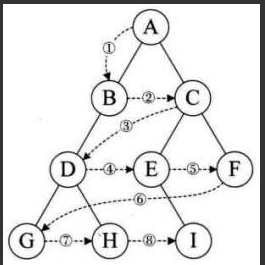1.树
1.1概念
树是一种非线性的数据结构,它是由n个有限节点组成一个具有层次关系。这种结构有以下特点:
- 一个特殊的结点,称为根节点,根节点没有前驱节点
- 除根节点以外,其余节点分成M个互不相交的集合。每个集合又是一颗和树类似的子树。每颗子树的根节点有且只有一个前驱,可以有0个或者多个后继。
- 树是递归定义的。
树形结构中,子树之间是不能有交集的,否则就不是树形结构。除了根节点以外,每一个节点有且只有一个父结点。
一棵树有N个节点就有N-1条边。
1.2概念
- 结点的度:一个结点含有子树的个数。
- 树的度:一棵树中,所有结点度最大值称之为树的度。
- 叶子结点或终端结点:度为0的结点称作叶子结点;
- 双亲结点或父结点:若一个结点含有子节点,则称这个结点为其子节点的父节点。
- 孩子结点或子结点:一个结点含有的子树的根节点乘坐该结点的子节点。
- 根结点:一棵树中,没有双亲结点的结点
- 结点的层次:从根开始定义,根为第一层,根的子结点为第2层
- 树的高度或深度:树中结点的最大层次
- 兄弟结点:具有相同父节点的结点互相称为兄弟结点
- 子孙:以某结点为根的子树中任一结点都称为该结点的子孙
- 森林:由m棵互不想接的树构成的集合称为森林
1.3树的表示形式
2二叉树
2.1概念
一颗二叉树是结点的有限集合,该集合:或者为空,或者是由一个根节点加上两颗别称为左子树和右子树的二叉树构成。
注意:
- 二叉树不存在度大于2的结点
- 二叉树的子树有左右之分,次序不可颠倒,因此二叉树是有序树
2.2两种特殊的二叉树
- 满二叉树:一颗二叉树,如果每层的节点数都达到最大值,则这颗二叉树是满二叉树,也就是说如果有一颗二叉树的层数为K,且结点总数为
,则他是满二叉树。
- 完全二叉树:完全二叉树是一种效率很高的数据结构,完全二叉树是由满二叉树引申出来的。对于深度为K的,有n个结点的二叉树,当且仅当其中每一个结点都与深度为K的满二叉树中从0到n-1的结点对应时才为完全二叉树。
2.3二叉树的性质
- 若根节点的层数为1,则一颗非空二叉树的第i层上最多有
个结点
- 若只有根节点的二叉树的深度为1,则深度为K 的二叉树党的最大结点数为
。
- 对于任何一棵二叉树,如果其叶节点个数为n0(度为0),度为2的非叶结点的个数为n2,则有
- 具有n个结点的完全二叉树的深度k为
向上取整
- 对于具有n个结点的完全二叉树,如果按照从上至下,从左至右的顺序对所有结点从0开始编号,则对于需要为i的结点有:
- 若i>0,双亲的序号为:
;若i=0,i为根节点编号,没有双亲结点
- 若2i+1<n,左孩子序号为
,否则没有左孩子
- 若2i+1>n,左孩子序号为
,否则没有右孩子
2.4二叉树的存储
存储结构分为:顺序存储和类似于链表形式的链式存储。二叉树的链式存储是通过一个一个的节点引用起来的,常见的表示方式有二叉和三叉表示方式,
2.5二叉树的基本操作
2.1二叉树的遍历
1.前中后序遍历
所谓遍历是指沿着某条搜索路线,因此对树种每个结点均做一次且仅做一次的访问。
- NLR:前序遍历(Preorder Traversal 亦称先序遍历)——访问根结点--->根的左子树--->根的右子树。
- LNR:中序遍历(Inorder Traversal)——根的左子树--->根节点--->根的右子树。
- LRN:后序遍历(Postorder Traversal)——根的左子树--->根的右子树--->根节点。
2.层序遍历
设二叉树的根节点所在 层数为1,层序遍历就是从所在二叉树的根节点出发,首先访问第一层的树根节点,然后从左到右访问第2层 上的节点,接着是第三层的节点,以此类推,自上而下,自左到右逐层访问树的结点的过程就是层序遍历。

2.5.二叉树的基本方法
//树种节点的个数
public void nodeSize(TreeNode root){
if(root==null) return ;
size++;
nodeSize(root.left);
nodeSize(root.right);
}
public int nodeSize2(TreeNode root){
if(root==null) return 0;
return nodeSize2(root.left)+nodeSize2(root.right)+1;
}
// 子问题思路-求叶子结点个数
public int leafSize=0;
public void getLeafNodeCount(TreeNode root){
if(root==null)return ;
if(root.left==null&root.right==null){
leafSize++;
}
getLeafNodeCount(root.left);
getLeafNodeCount(root.right);
}
//左数的叶子+右数的叶子
public int getLeafNodeCount2(TreeNode root){
if(root==null)return 0;
if(root.left==null&&root.right==null){
return 1;
}
return getLeafNodeCount2(root.left)+getLeafNodeCount2(root.right);
}
//第K层结点的个数
public int getKLevelNodeCount(TreeNode root,int k){
if(root==null) return 0;
if(k==1){
return 1;
}
return getKLevelNodeCount(root.left,k-1)+
getKLevelNodeCount(root.right,k-1);
}
// 获取二叉树的高度
public int getHeight(TreeNode root){
if(root==null) return 0;
int leftHeight=getHeight(root.left);
int rightHeight=getHeight(root.right);
return (leftHeight>rightHeight? leftHeight+1:rightHeight+1);
}
// 检测值为value的元素是否存在
public boolean find(TreeNode root,char key){
if(root==null)return false;
if(root.val==key){
return true;
}
boolean leftVal=find(root.left,key);
if (leftVal==true){
return true;
}
boolean rightVal=find(root.right,key);
if(rightVal==true){
return true;
}
return false;
}
//层序遍历
public void levelOrder1(TreeNode root){//层序遍历
if(root==null){return;}
Queue<TreeNode> queue=new LinkedList<>();
queue.offer(root);
while(!queue.isEmpty()){
TreeNode cur=queue.poll();
System.out.println(cur.val+" ");
if(cur.left!=null){
queue.offer(cur.left);
}
if(cur.right!=null){
queue.offer(cur.right);
}
}
}
public List<List<TreeNode>> levelOrder2(TreeNode root){//层序遍历
List<List<TreeNode>> ret=new ArrayList<>();
if(root==null){return ret;}
Queue<TreeNode> queue=new LinkedList<>();
queue.offer(root);
while(!queue.isEmpty()){
int size= queue.size();//当前队列的大小
List<TreeNode> tmp=new ArrayList<>();
while (size!=0){
TreeNode cur=queue.poll();
tmp.add(cur);
size--;
if(cur.left!=null){
queue.offer(cur.left);
}
if(cur.right!=null){
queue.offer(cur.right);
}
}
ret.add(tmp);
}
return ret;
}
2.5.3常见0j
判断一棵树是否是完全二叉树
// 判断一棵树是不是完全二叉树
public boolean isCompleteTree(TreeNode root){
if(root==null) return false;
Queue<TreeNode> queue=new LinkedList<>();
queue.offer(root);
while(!queue.isEmpty()){
TreeNode cur=queue.poll();
if (cur!=null){
queue.offer(root.left);
queue.offer(root.right);
}else {
break;
}
}
while (!queue.isEmpty()){
TreeNode cur=queue.poll();
if(cur==null){
return false;
}
}
return true;
}思路:先把当前节点放入队列中,再弹出元素判断是否为空节点,若不为空将该节点的左右节点再入队,一直到队列中都为空。再挨个弹出队列中所剩下的元素,遇到null就说明不是完全二叉树。若非空说明元素都是按序排列的。
class Solution {
public boolean isSameTree(TreeNode p, TreeNode q) {
if(p==null&&q!=null||p!=null&&q==null){
return false;
}
if(p==null&&q==null){
return true;
}
if(p.val!=q.val){
return false;
}
return isSameTree(p.left,q.left)&&isSameTree(p.right,q.right);
}
}思路:定义两个节点位于两棵树,若一个节点为空一个不为空,说明不是相同的树。若两个节点都为空,说明是两颗空树,则相同。若两个节点的值不相同,则不相同。遍历两树的左子树和右子树,只有当左右子树都相同的时候才是相同的树。
class Solution {
public boolean isSubtree(TreeNode root, TreeNode subRoot) {
if(root==null){
return false;
}
if(isSameTree(root,subRoot)){
return true;
}
return isSubtree(root.left,subRoot)||isSubtree(root.right,subRoot);
}
private boolean isSameTree(TreeNode p,TreeNode q){
if(p==null&&q!=null||p!=null&&q==null){
return false;
}
if(p==null&&q==null){
return true;
}
if(p.val!=q.val){
return false;
}
return isSameTree(p.left,q.left)&&isSameTree(p.right,q.right);
}
}思路与相同树类似。只不过可能从根结点处开始相同,也有可能与左右子树中任意一棵子树相同。
class Solution {
public TreeNode invertTree(TreeNode root) {
if(root==null){return null;}
TreeNode tmp=root.left;
root.left=root.right;
root.right=tmp;
invertTree(root.left);
invertTree(root.right);
return root;
}
}class Solution {
public boolean isBalanced(TreeNode root) {
return getHeight(root) != -1;
}
private int getHeight(TreeNode root) {
if (root == null) {
return 0;
}
int leftHeight = getHeight(root.left);
if (leftHeight == -1) {
return -1; // 左子树不平衡
}
int rightHeight = getHeight(root.right);
if (rightHeight == -1) {
return -1; // 右子树不平衡
}
if (Math.abs(leftHeight - rightHeight) > 1) {
return -1; // 当前节点不平衡
}
return Math.max(leftHeight, rightHeight) + 1;
}
}思路:平衡二叉树的概念是:平衡二叉树是指该树所有节点的左右子树的高度相差不超过 1。基本思路与求树的高度相同,遍历左右子树计算子树的高度,比较高度并加1。但是这里为预防重复计算高度设置一个-1值说明该子树已经不平衡了。
class Solution {
public boolean isSymmetric(TreeNode root) {
if(root==null){
return true;
}
return isSymmetricChild(root.left,root.right);
}
public boolean isSymmetricChild(TreeNode p,TreeNode q){
if(p==null&&q!=null||p!=null&&q==null){
return false;
}
if(p==null&&q==null){
return true;
}
if(p.val!=q.val){
return false;
}
return isSymmetricChild(p.left,q.right)&&isSymmetricChild(p.right,q.left);
}
}思路:遍历左右子树,当p.left==q.right且p.right==q.left时才满足对称。
给定一个字符串生成一个二叉树
编一个程序,读入用户输入的一串先序遍历字符串,根据此字符串建立一个二叉树(以指针方式存储)。 例如如下的先序遍历字符串: ABC##DE#G##F### 其中“#”表示的是空格,空格字符代表空树。
public static int i = 0;
public static TreeNode creatrTree(String str) {
TreeNode root = null;
if(str.charAt(i) != '#') {
root = new TreeNode(str.charAt(i));
i++;
root.left = creatrTree(str);
root.right = creatrTree(str);
}else {
i++;
}
return root;
}
}
思路:按照先序遍历的方式创建二叉树。
class Solution {
public TreeNode lowestCommonAncestor(TreeNode root, TreeNode p, TreeNode q) {
if(root==null)return null;
if(root==p||root==q){
return root;
}
TreeNode left=lowestCommonAncestor(root.left,p,q);
TreeNode right=lowestCommonAncestor(root.right,p,q);
if(left!=null&&right!=null){
return root;
}else if(left==null){
return right;
}else{
return left;
}
}
}
思路:p,q若分别位于左右子树上那么最近公共祖先一定是根节点。若一个位于左或右子树上,一个位于根节点,那么根节点就是最近公共祖先。
class Solution {
public int preindex=0;
public TreeNode buildTree(int[] preorder, int[] inorder) {
return buildTreeChild(preorder,inorder,0,inorder.length-1);
}
private TreeNode buildTreeChild(int[] preorder,int[] inorder,int inbegin,int inend){
if(inbegin>inend){
return null;
}
TreeNode root=new TreeNode(preorder[preindex]);
int rootIndex=findIdex(inorder,inbegin, inend,preorder[preindex] );
if(rootIndex==-1){
return null;
}
preindex++;
root.left=buildTreeChild(preorder,inorder,inbegin,rootIndex-1);
root.right=buildTreeChild(preorder,inorder,rootIndex+1,inend);
return root;
}
private int findIdex(int[] inorder,int inbegin,int inend,int key){
for(int i=inbegin;i<=inend;i++){
if(inorder[i]==key){
return i;
}
}
return -1;
}
}思路:按照手动画树的思路,前序遍历第一个数就是根节点,而中序遍历以这个数分作左右两棵子树。那么遍历前序遍历数组,并在中序遍历数组中找到对应下标,构建根节点。同时按照中序遍历顺序先构建左子树再构建右边子树。在中序遍历数组定义一个数组开头和结尾。调用是改变结尾或者开头的位置,一直到开头下标大于结尾下标时,说明子树构建完成。
class Solution {
public int postIndex;
public TreeNode buildTree(int[] inorder, int[] postorder) {
postIndex=postorder.length-1;
return buildTreeChild(postorder,inorder,0,inorder.length-1);
}
private TreeNode buildTreeChild(int[] postorder,int[] inorder,int inbegin,int inend){
if(inbegin>inend){
return null;
}
TreeNode root=new TreeNode(postorder[postIndex]);
int rootIndex=findIdex(inorder,inbegin, inend,postorder[postIndex]);
if(rootIndex==-1){
return null;
}
postIndex--;
root.right=buildTreeChild(postorder,inorder,rootIndex+1,inend);
root.left=buildTreeChild(postorder,inorder,inbegin,rootIndex-1);
return root;
}
private int findIdex(int[] inorder,int inbegin,int inend,int key){
for(int i=inbegin;i<=inend;i++){
if(inorder[i]==key){
return i;
}
}
return -1;
}
}思路:与前中序遍历创建子树同理。后序遍历最后一个节点为根节点。且子树创建顺序应该是先右子树后左子树。
class Solution {
public String tree2str(TreeNode root) {
StringBuilder stringBuider=new StringBuilder();
tree2strChild(root,stringBuider);
return stringBuider.toString();
}
private void tree2strChild(TreeNode t,StringBuilder stringBuider){
if(t==null){
return;
}
stringBuider.append(t.val);
if(t.left!=null){
stringBuider.append("(");
tree2strChild(t.left,stringBuider);
stringBuider.append(")");
}else{
if(t.right==null){
return ;
}else{
stringBuider.append("()");
}
}
if(t.right!=null){
stringBuider.append("(");
tree2strChild(t.right,stringBuider);
stringBuider.append(")");
}else{
return ;
}
}
}思路:左子树不为空的时候添加左括号,在添加字符后添加右括号。若右子树节点为空那么添加左右括号。可以将情况分为:1左边不为空(右边为空,右边不为空)2.左边为空(右边为空,右边不为空)3.右边空4.右边不为空。
(非递归遍历)
class Solution {
public List<Integer> postorderTraversal(TreeNode root) {
List<Integer> res=new ArrayList<Integer>();
if(root==null) return res;
Stack<TreeNode> stack=new Stack<>();
TreeNode cur=root;
TreeNode top=null;
TreeNode prev=null;
while(cur!=null||!stack.isEmpty()){
while(cur!=null){
stack.push(cur);
cur=cur.left;
}
top=stack.peek();
if(top.right==null||top.right==prev){
stack.pop();
res.add(top.val);
prev=top;//当前结点被打印过了
}else{
cur=top.right;
}
}
return res;
}
}